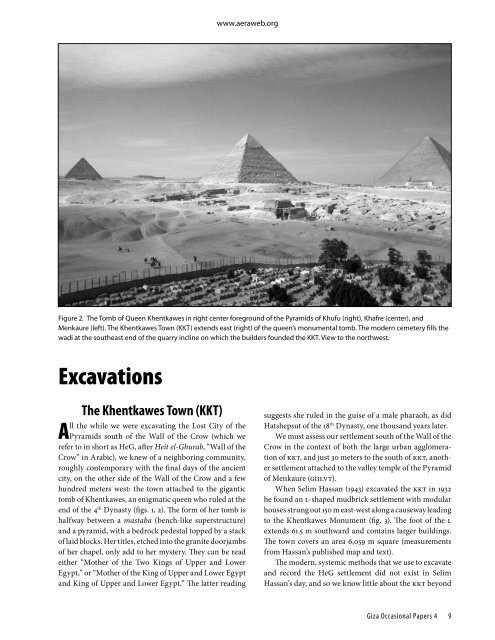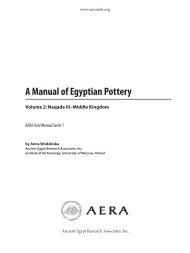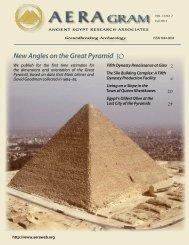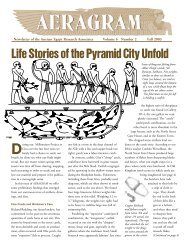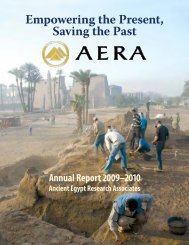The Khentkawes Town (KKT) - Ancient Egypt Research Associates
The Khentkawes Town (KKT) - Ancient Egypt Research Associates
The Khentkawes Town (KKT) - Ancient Egypt Research Associates
Create successful ePaper yourself
Turn your PDF publications into a flip-book with our unique Google optimized e-Paper software.
www.aeraweb.org<br />
Figure 2. <strong>The</strong> Tomb of Queen <strong>Khentkawes</strong> in right center foreground of the Pyramids of Khufu (right), Khafre (center), and<br />
Menkaure (left). <strong>The</strong> <strong>Khentkawes</strong> <strong>Town</strong> (<strong>KKT</strong>) extends east (right) of the queen’s monumental tomb. <strong>The</strong> modern cemetery fills the<br />
wadi at the southeast end of the quarry incline on which the builders founded the <strong>KKT</strong>. View to the northwest.<br />
Excavations<br />
<strong>The</strong> <strong>Khentkawes</strong> <strong>Town</strong> (<strong>KKT</strong>)<br />
All the while we were excavating the Lost City of the<br />
Pyramids south of the Wall of the Crow (which we<br />
refer to in short as HeG, after Heit el-Ghurab, “Wall of the<br />
Crow” in Arabic), we knew of a neighboring community,<br />
roughly contemporary with the final days of the ancient<br />
city, on the other side of the Wall of the Crow and a few<br />
hundred meters west: the town attached to the gigantic<br />
tomb of <strong>Khentkawes</strong>, an enigmatic queen who ruled at the<br />
end of the 4 th Dynasty (figs. 1, 2). <strong>The</strong> form of her tomb is<br />
halfway between a mastaba (bench-like superstructure)<br />
and a pyramid, with a bedrock pedestal topped by a stack<br />
of laid blocks. Her titles, etched into the granite doorjambs<br />
of her chapel, only add to her mystery. <strong>The</strong>y can be read<br />
either “Mother of the Two Kings of Upper and Lower<br />
<strong>Egypt</strong>,” or “Mother of the King of Upper and Lower <strong>Egypt</strong><br />
and King of Upper and Lower <strong>Egypt</strong>.” <strong>The</strong> latter reading<br />
suggests she ruled in the guise of a male pharaoh, as did<br />
Hatshepsut of the 18 th Dynasty, one thousand years later.<br />
We must assess our settlement south of the Wall of the<br />
Crow in the context of both the large urban agglomeration<br />
of <strong>KKT</strong>, and just 30 meters to the south of <strong>KKT</strong>, another<br />
settlement attached to the valley temple of the Pyramid<br />
of Menkaure (GIII.VT).<br />
When Selim Hassan (1943) excavated the <strong>KKT</strong> in 1932<br />
he found an L-shaped mudbrick settlement with modular<br />
houses strung out 150 m east-west along a causeway leading<br />
to the <strong>Khentkawes</strong> Monument (fig. 3). <strong>The</strong> foot of the L<br />
extends 61.5 m southward and contains larger buildings.<br />
<strong>The</strong> town covers an area 6,059 m square (measurements<br />
from Hassan’s published map and text).<br />
<strong>The</strong> modern, systemic methods that we use to excavate<br />
and record the HeG settlement did not exist in Selim<br />
Hassan’s day, and so we know little about the <strong>KKT</strong> beyond<br />
Giza Occasional Papers 4 9


